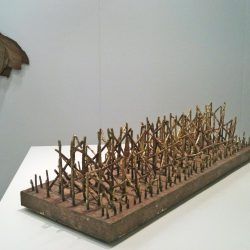
For Sumatra (Man-Made Weather)
With the exhibition "For Sumatra (Man-made Weather)“ a monument for the venting system of the Sumatran tobacco barn shall be erected. The monument comprises three parts: a model, a manual, and a film. Tobacco barns are both highly localised and globalised building types. They are, with a word of the Swiss writer and tobacco fetishist Herman Burger, the "tobacco cathedrals“ of the globalized tobacco production, which spread worldwide since the second half of the 19th century. In these buildings, vernacular, informal, industrial and modern influences are overlaid on top of one another. Tobacco barns are large-scale drying equipment designed to enable the curing of tobacco leaves by modifying microclimatic conditions. The main objective of tobacco barns, in which the tobacco leaves are hung to dry, is the production of relatively uniform climatic conditions inside. The three main climatic parameters air temperature, relative humidity and wind velocity must be brought under the control of the tobacco producers. A successful curing process protects the leaves from larger fluctuations of these three parameters inside of the buildings. Based on fieldwork conducted in 2013 and 2014 in the former Swiss colonial plantation "Helvetia“, near the city of Medan (Sumatra, Indonesia), the exhibition presents the structure and the mechanisms of these passive houses.